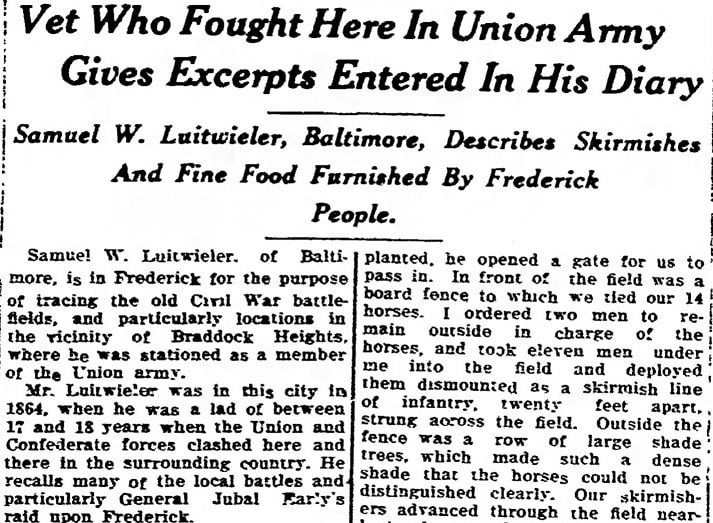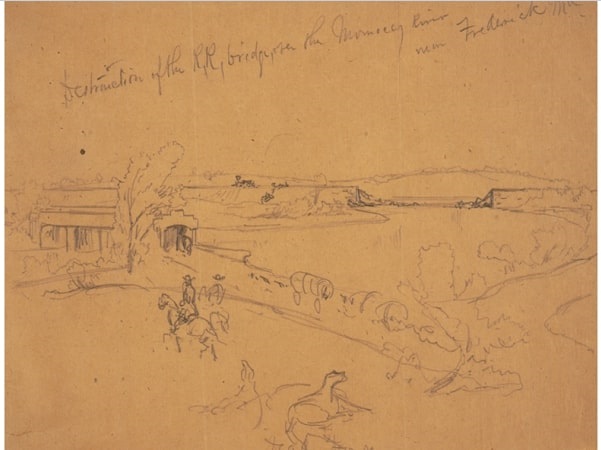Introduction: In this article, Melissa Davenport Berry writes about a Civil War veteran who returned to Maryland battlefields in 1924 to reminisce and reflect. Melissa is a genealogist who has a blog, AnceStory Archives, and a Facebook group, New England Family Genealogy and History.
“The battle of Monocacy was on – the skirmishers were at work. Later, I saw the battle lines surging in charges and drives throughout the day from the vantage view on the hill side. Late in the afternoon the ambulances came by; the beginning of a retreat had started. [There were] many wounded men in the ambulances who had not had first aid, and the roadway was being sprinkled from the wounds of the soldiers’ blood coming from the cracks in the floor of the ambulances. A little later came General Lew Wallace tearing down the roadway.”
–Samuel Woods Luitwieler from his diary entry of 9 July 1864

In July of 1924 Samuel Woods Luitwieler (1847-1931), a successful entrepreneur, traveled from California to Frederick County, Maryland, to visit the old Civil War battlefields. He was particularly interested in locations in the vicinity of Braddock Heights, where he was stationed and fought as a member of the 1st New York Veteran Cavalry Regiment for the Union army 50 years earlier.
When Samuel visited the area, he brought along his diary that he had kept during the war. The Associated Press published some of the extracts under the title “Vet Who Fought Here in Union Army Gives Excerpts Entered in His Diary.”

The diary entries include Confederate General Jubal Early’s raid upon Frederick, and sporadic skirmishes between Union and Confederate forces leading up to the Battle of Monocacy, better known as “The Battle That Saved Washington.”
Before I begin with Samuel’s wartime adventures, here is a little background on the diarist. Samuel was born in Rochester, New York, to Jacob Gerardus Luitwieler and Matilda Sarah Woods. He married Miss Sophia Charlotte Maurer of Rochester and they had six children. During his long career he served as president of both the Los Angeles and Pacific Railway Company and Los Angeles and Santa Monica Land and Water Company.
However, he received the most fame from his patented inventions (a total of 16) to improve the water pump for his business, the Luitwieler Cam Pump Company, as well as other machine parts and equipment. Samuel was also one of the largest suppliers of famous Studebaker farm machinery.
When Samuel shared his diary with the press, he recalled one particular incident when he was mistaken for a lieutenant and selected by his commanding officer to gather a number of men to meet a scouting party of Confederates who were sent out to locate the Union forces.
Here are some pages from his diary:
July 7, 1864.
The regiment was in camp at Leesburg. Virginia. At 5 o’clock orders came for the company to saddle up and go on a scout to find Early’s advance.
We passed outside of camp and found our picket at a house beside the road. We had proceeded about 300 yards, when ahead of us on the edge of the road, a Confederate battery of artillery was concealed in a piece of forest.
Our first intimation was shell from a gun in the road ahead of us about a thousand feet distant. Our captain ordered the command to the right into a field facing the battery, which commenced shelling us.
One of the shells struck the ground 300 feet in advance of my horse and broke. One piece came in direct line to me. I laid down close to my horse’s neck thinking the piece would hit me in the head.
It passed directly over my head and hit Jim Clapper in the shoulder, breaking his collar bone. Capt. [Allen] Vanderboget, realizing that it would be useless to keep the company in line for a target for the Rebel battery, ordered the company about and fell back in the direction of the camp.
By this time the regiment was alarmed by the sound of artillery firing, and by the time we reached the camp the whole regiment was in saddle awaiting our return. Skirmishing began and continued by our falling back in slow retreat throughout the day. The enemy force outnumbered us, and we had no artillery.
We held them back by slow retreat fighting all the way towards the Potomac River. We made a stand as darkness came on and went into camp about a mile south of the Potomac River.
We were ordered to collect brush and make fires in lines representing company streets to deceive the rebels and make them think we had received big reinforcements. After getting breakfast, orders came to saddle up and cross the Potomac at a ford.
On the north side of the river were some large tobacco warehouses we noticed in passing and a deep dugway up the bank. After we had passed up through the dugway about a mile Capt. Vanderboget came to me and said:
I want you and Ed Goodell to report back to the river [to look] for General Stohl [Confederate General Otho Franch Stohl]. We rode back as fast as possible.
When we got there, we saw only sharpshooters engaged with the rebels on the opposite shore of the Potomac. Upon inquiry we found General Stohl had not been seen there.
So we again retraced our route up the dugway but at a much greater speed, for the rebel sharpshooters took us for officers, being mounted, and sent a shower of bullets after us. Fortunately, none of them hit us and we escaped.
To be continued…
Explore over 330 years of newspapers and historical records in GenealogyBank. Discover your family story! Start a 7-Day Free Trial
Check out this video: Civil War “The Battle of Monocacy” 125th Anniversary – Re-enacting Retro
Note on the header image: “Destruction of the R.R. bridge, over the Monocacy River near Frederick, Md.” Scene depicts damage caused by Confederate raid, 9 July 1864. Credit: Alfred R. Waud, 1828-1891, artist; Library of Congress, Prints and Photographs Division.
